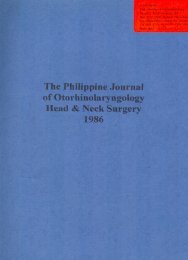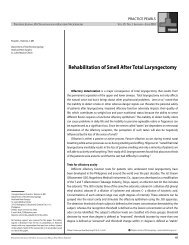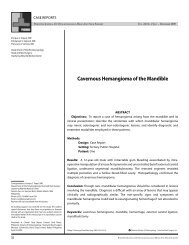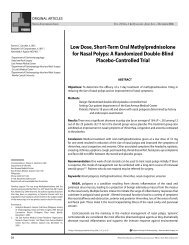Create successful ePaper yourself
Turn your PDF publications into a flip-book with our unique Google optimized e-Paper software.
x-ray revealed a dense tortuous cylindrical nodule at leukemia and aplastic anemia were ruled out because<br />
the posterior RUL and a pleurodiaphragmatic adhe- of a normal blood morphology and bone marrow<br />
sion on the left. Possibility of an A-V malformation findings.<br />
and TB granuloma was entertained. Pulmonary and<br />
carotid arteriography were contemplated but was not Hereditary Hemorrhagic Telangiectasia is the more<br />
done due to financial constraint. ECG was normal, probable consideration for this case. It is autosomal<br />
ABG showed hypoxemic hypocardia. Two units of dominant disease characterized as a sytemic fibrovas-<br />
FWB were tranfused. Post BT Hgb and Hct were. cular dysplasia in which telangiectasia, A-V malforlow,<br />
patient continued to have on and off epistaxis mation and aneurysm maybe widely distributed through<br />
necessitating transfusion of 4 units of FWB in a week out the body vasculature. This is recognized as a<br />
time. classic triad of telangiectasia, recurrent bleeding and<br />
family history. The lesions maybe pinpoint in size<br />
On the 10th hospital day bone mar'row aspiration or larger and form nodular vascular tumor, sometimes<br />
biopsy was done to rule out blood dyscrasia, result it appear as a spider-like lession. Significant syruprevealed<br />
normal bone marrow findings, tomatology include recurrent bleeding from mucosal<br />
telangiectasia, hypoxemia, cerebral embOlism and brain<br />
On the 13th hospital day the patient bled pro- abscess due to pulmonary A-V malformation.<br />
fusely, she underwent emergency bilateral external<br />
carotid artery ligation in an attempt to control epis- Epistaxis is the most common form of bleeding<br />
taxis. Post operative Hgb and Hct were still below and it is the first hemorrhagic event in I_Iereditary<br />
normal value prompting another series of blood trans- Hemmorhagic Telangiectasia. In our patient several<br />
fusion. Patient continued to have episodes of epis- attempts have been done to control epistaxis i.e., local<br />
taxis which spontaneously stopped. Rigid nasopharyn- pressure, anterior and posterior nasalpacking, ligation<br />
goscopy was done revealing an erythematous maculo- of the blood supply of nasal cavity . Yet inspite of<br />
papular lesion on the left side ol_ the nasal septum these interventions, there were still episodes of bleedlocated<br />
posteriorly, ing. Bilateral external carotid artery ligation completely<br />
failed to control the hemorrhagic event in this<br />
Upon discharge patient continued to experience patient because of the rich vascular channols supplyepistaxis<br />
relieved by local pressure. Two months later ing the nasal cavity.<br />
profuse nose bleeding recurred and she lost consciousness<br />
for which she was rushed to Ospital ng Maynila Hereditary Hemorrhagic Telangiectasia is the most<br />
and was re-admitted. Contrast C.T. scan was done common disease associated wth pulmonary A-V fiswhich<br />
revealed normal findings, tula. Pulmonary fistula maybe solitary of multiple,<br />
majority of which • receive blood supply from the<br />
In summmary, we are presented with a 31 y.o pulmonary artery and are right to left shunts. Right<br />
female patient with the following salient features; to left shunts allows desaturated blood to enter the<br />
recurrent epistaxis, erythematous maculo-papular systematic circulation to cause cyanosis by hypoxemia,<br />
lesion on the nasal septum clubbing and cyanosis of polycythemia and clubbing.<br />
nail beds, a blowing murmur at the right interscapular<br />
area which appear to be extracardiac in origin, normal On chest x-ray the typical pulmonary A-V<br />
hematologic studies except for anemia, possibility of malformation is peripheral, circumscribed, aon calcific<br />
an A-V formation on chest radiography and a family nodule connected to the hilus by vascultr strands.<br />
history which revealed that her grandmother had similar<br />
experience. Withthese, the possible underlying cause Management of this case is variable depending<br />
of recurrent epistaxis should be explored, on the severity of the disease. Oral iron and folic<br />
acid supplements maybe necessary to avoid iron<br />
Infection would not produce such prolonged and deficiency. Transfusion requirements were variable.<br />
massive epistaxis. There was no history nor evidence<br />
of recent nasal truma. Patient was not hypertensive. Treatment modalities to control bleeding such as<br />
Hematologic dysfunctions such as acute leukemia, local pressure, topical vasoconstrictors, claemical or<br />
aplastic anemia, and Heriditary Hemorrhagic Telang- electrical cat, tery and arterial ligaton offer only<br />
iectasia should be considered. However, acute<br />
47
















